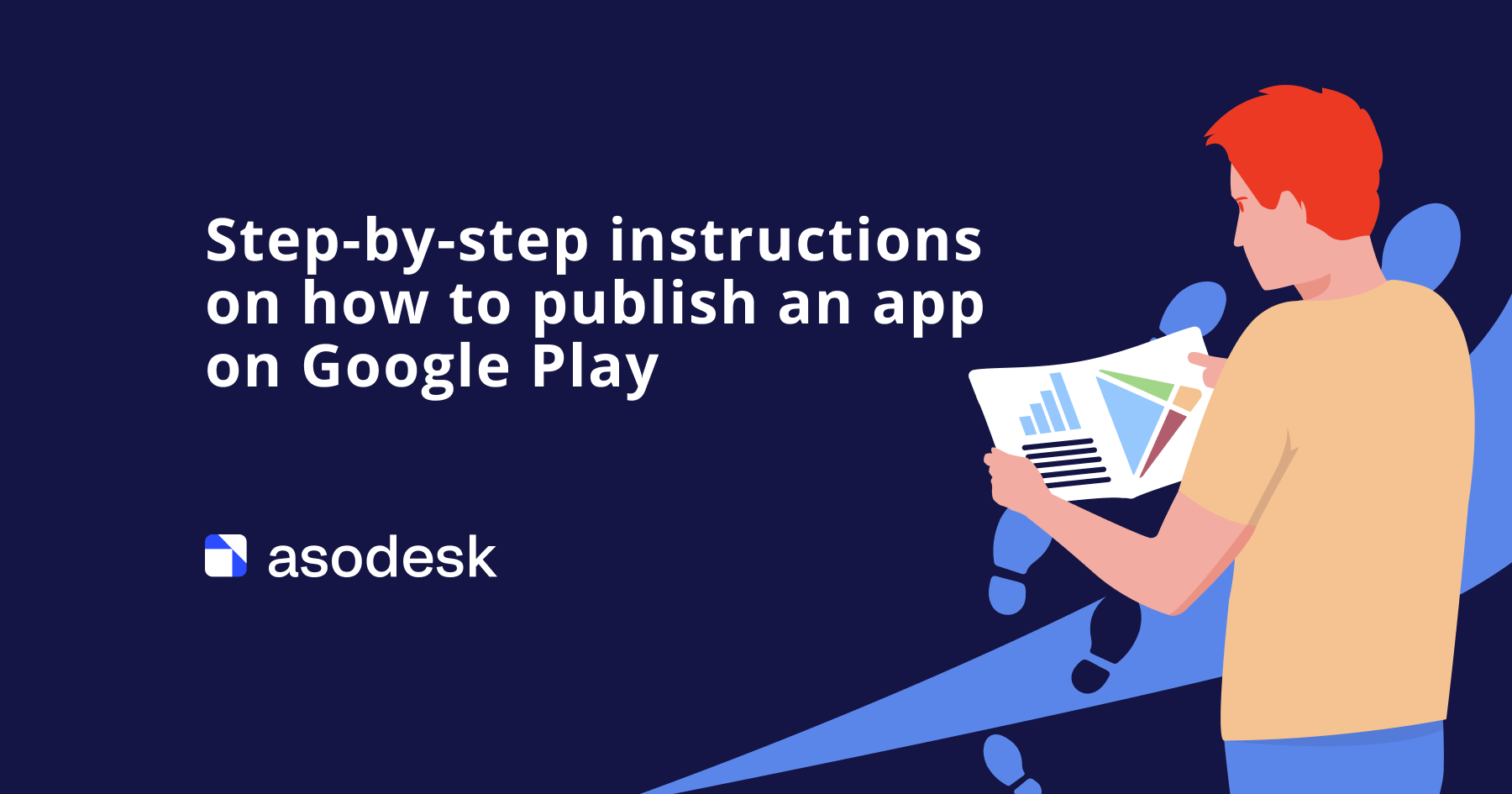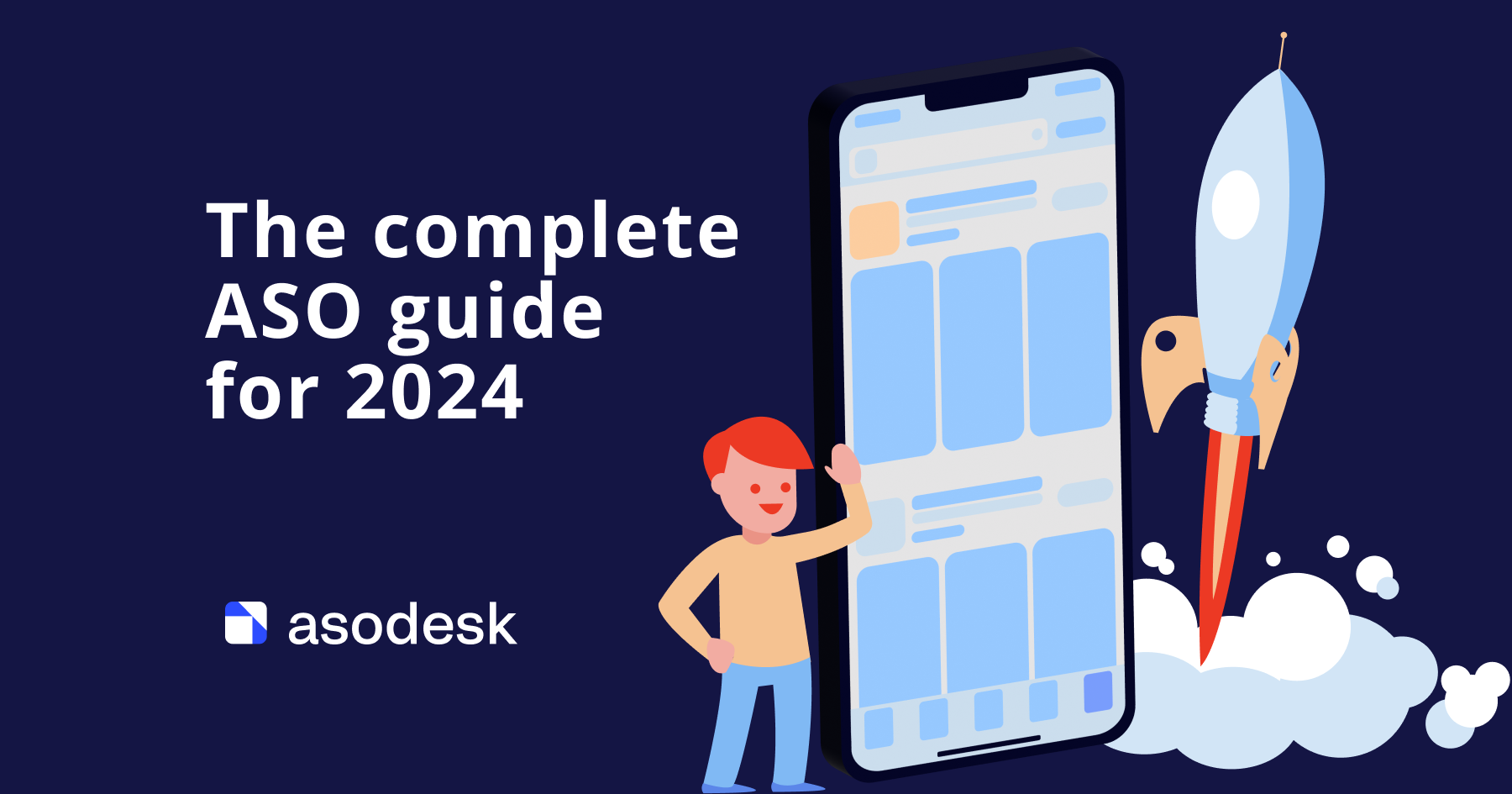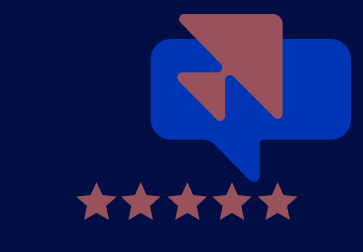Top 12 mobile app marketing strategies

If you are not getting the desired results from your app promotion, you may be missing out on effective mobile app marketing strategies. In this article, we will explain the best marketing strategies for apps, discuss when you should implement them, and show how to apply them.
This article was written by Julia Suliagina, a content manager at Asodesk, and Natalia Stepanova, a mobile marketer with a passion for mobile gaming market research and writing.
Contents
What to do before implementing mobile app marketing strategies
1. Conducting App Store Optimization
2. Running Paid UA campaigns
3. Working on reviews and ratings for your app
4. Getting your app featured
5. Launching push notifications
6. Working on SMM
7. Using influencer marketing
8. Publishing articles and press releases about your app
9. Creating a referral system
10. Building a community around your brand
11. Developing a website for your app
12. Running email campaigns
How to promote your app with 12 app marketing strategies
What to do before implementing mobile app marketing strategies
Before implementing any marketing strategy for mobile apps, it is important to define your target audience, find the right market, and analyze your competitors. Let’s look at each point in more detail:
1. Define your target audience. You need to identify who your potential users are, their demographics, interests, pain points, and behaviors. By understanding your target audience, you can develop messaging that will appeal to them and select the most effective channels to reach them.
2. Find your target market. Choosing the right country for your app can have a significant impact on your results. When selecting a target country, it’s important to consider factors such as the size of the market, cultural and linguistic differences, user behaviors and preferences, and regulatory requirements.
3. Analyze your competitors. Research your app category and find at least 5 of your top competitors. Study each app’s monetization model, current selling price, app store ranking, notable reviews, and UX (user experience) pros and cons. You can even take your competitor analysis further by performing a competitive metric to find out how your mobile app compares. Tools such as Apptica give a holistic view of the market, competitors’ performance, and UA activity.
After you have defined your target audience, selected the right markets and analyzed your competitors, it is time to choose the best app marketing strategies for your apps.
1. Conducting App Store Optimization
App Store Optimization (ASO) is the process of improving app visibility within the app stores and increasing app conversion rates. ASO can help to promote your app to the top of the App Store and Google Play, allowing you to attract installs from search while also improving conversion rates from browse and paid ads.
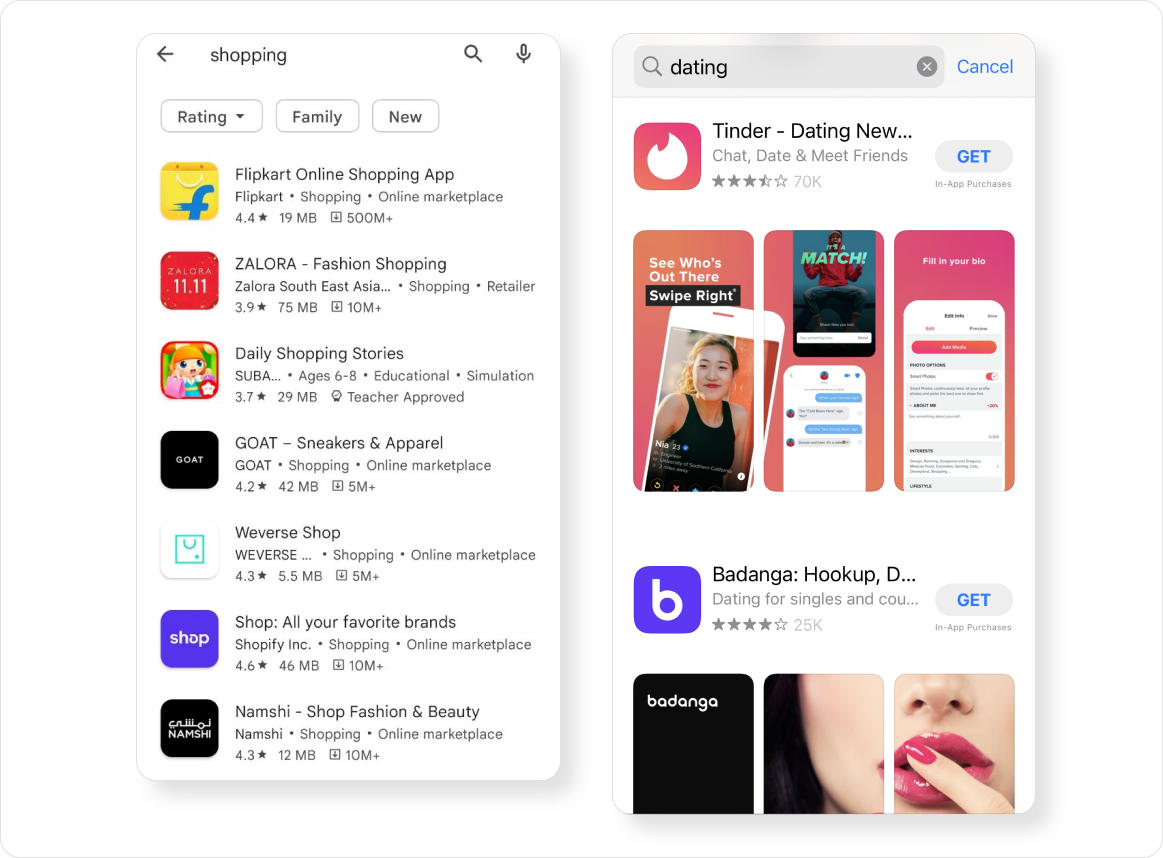
Almost all apps need at least basic ASO, as it influences not only your visibility in the app stores but also your conversion to install rate from all traffic sources, as users finally come to your app page from all traffic channels.
However, some categories of apps require less ASO while others require more. This depends on an app’s search traffic and non-branded traffic. In our global research paper, you can find out if ASO is necessary for your app category.
App Store Optimization is a continuous process, that should be done step-by-step. Here are the steps that you should follow.
1. Create a semantic core. Start by creating a list of relevant keywords that users might search for when looking for an app like yours.
2. Prepare app metadata. Use the keywords you’ve identified to optimize your app’s metadata, including the title, subtitle, and description.
3. Evaluate ASO effectiveness. Track your app’s performance and monitor changes in its ranking to evaluate the effectiveness of your ASO efforts.
4. Work with iterations. Continuously make changes to your app’s metadata and monitor the results to improve your ASO strategy.
5. Find app growth hypotheses. Identify hypotheses that you believe will help your app grow, such as improving your app’s user experience or adding new features.
6. Work with keyword management. Manage your keywords by tracking their performance and making changes as needed.
7. Monitor keywords. Regularly monitor your app’s keywords and rankings to identify trends and adjust your ASO strategy accordingly.
7. Analyze your competitors. Analyze your competitors’ app store listings and identify what they’re doing well and where they could improve.
8. Localize your app page for other countries. If you’re targeting users in other countries, localize your app’s page to cater to their language and cultural preferences.
Asodesk has everything you need for full-cycle App Store Optimization. You can try our tools for free with a 14-day trial.

Read how to complete all ASO tasks with Asodesk tools in this article.
2. Running Paid UA campaigns
User Acquisition (UA) campaigns involve investing money to advertise your app through various digital channels to attract new users. The decision to run paid User Acquisition campaigns should be based on a thorough analysis of your app’s specific situation and goals — including competition, target audience, and budget.
Here are some steps you can take to set up and run a paid UA campaign:
1. Define your campaign goals. This is essential before starting any paid UA campaign.
2. Determine your budget. Consider your goals, target audience, and the cost of advertising on various channels to determine your budget.
3. Choose your advertising channels. This includes social media platforms, search engines, and in-app advertising networks. Select the channels that align with your goals and target audience.
4. Create compelling ads. Use eye-catching visuals, clear and concise copy, and a strong call to action.
For example, Postmates had come up with a creative and engaging Snapchat ad for app installs, which is sure to grab users’ attention. In order to reveal their coupon code, users are required to tap (and do so cleverly) on a button that shatters a glass.

5. Set up your targeting options. Consider demographics, interests, behaviors, and locations to ensure that your ads are shown to the right audience.
6. Track and optimize your campaign: Monitor your campaign performance using relevant metrics such as impressions, clicks, installs, and conversion rates.
7. Test and experiment. Try different ads, targeting options, and advertising channels to find what works best for your app.
Running paid UA campaigns is an important app marketing strategy for almost any mobile app looking to acquire new users and increase engagement. By leveraging various digital channels, you can reach a wider audience, increase brand awareness, and drive app installs. Learn how to create a winning UA strategy for your app in this article.
3. Working on reviews and ratings for your app
Reviews and ratings are a critical aspect of any mobile app’s success. They can influence potential users’ decisions to download or use an app and can impact the app’s rankings in app store search results. Here are some steps you can take to work with reviews and ratings effectively:
1. Respond to reviews. Responding to reviews, both positive and negative, shows users that you are considering their feedback and care about their experience. It also provides an opportunity to address any issues that users may have and improve the app’s overall quality.
On Asodesk, you can respond to all app reviews and report concerns about unfair reviews with the Reviews & Replies Board. It also provides feedback filters according to response, rating, date, tags, text, and number of characters.
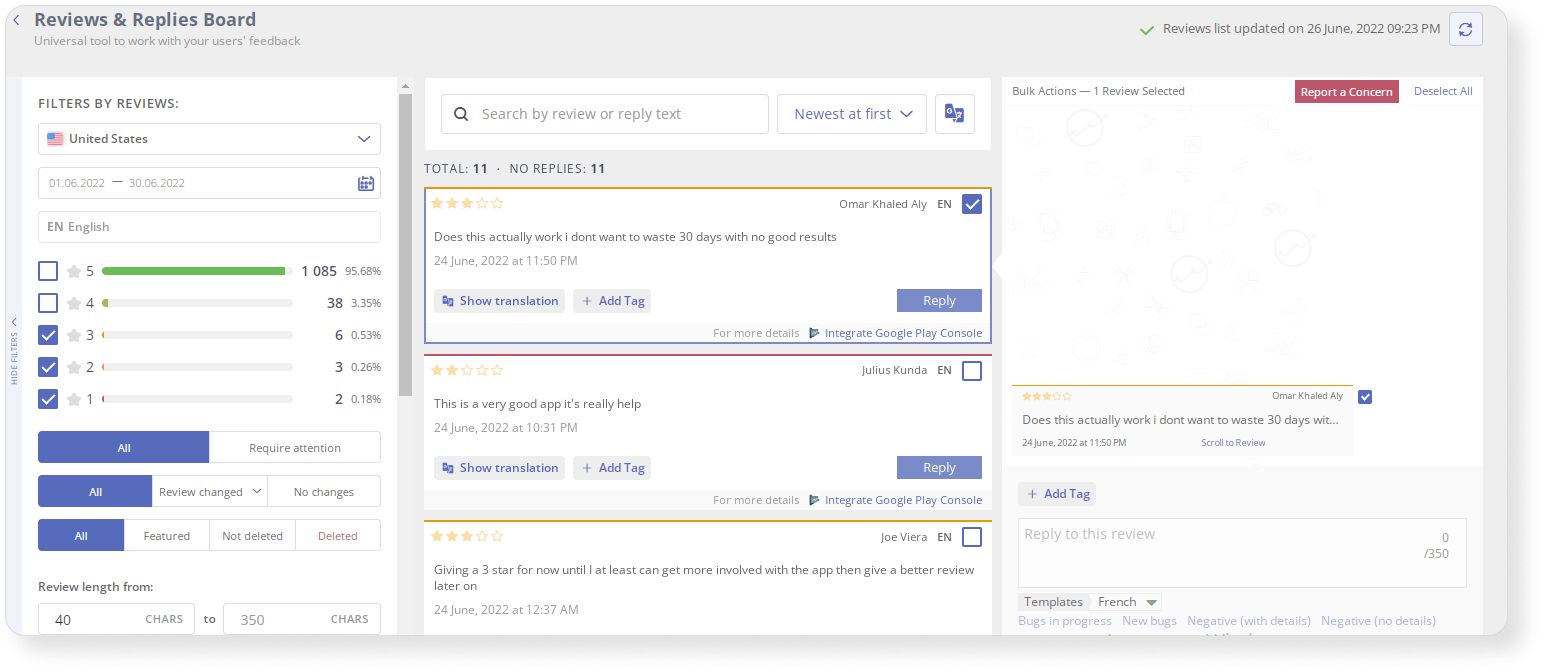
2. Encourage users to leave reviews. You can do this by prompting users within the app to leave a review or by offering incentives for a review.
3. Monitor reviews and ratings to identify any issues or trends that may be affecting your app’s overall user experience.
4. Learn what to improve in your app from reviews. Use this feedback to make necessary changes and improvements to your app, such as fixing bugs, supplementing features, or enhancing the overall user experience.
Working with reviews and ratings is essential for any app store marketing strategy. Responding to reviews, encouraging users to leave reviews, monitoring reviews and ratings, and using them to improve your app can all help maintain positive user sentiment and improve the overall user experience. Download our PDF guide for 33 tips on how to work with reviews.
4. Getting your app featured
Getting your app featured on the App Store or Google Play can greatly increase its visibility and drive more downloads. However, with millions of apps available, it can be challenging to stand out and catch the attention of app store curators.
Here are some steps you can take to get your app featured:
1. Focus on quality. Ensure that your app is user-friendly, visually appealing, and functions smoothly.
2. Optimize your app page. To ensure a good presentation of your app, it’s important to optimize your metadata with relevant keywords and pay attention to your creative assets, including the app icon, screenshots, and video.
3. Regularly update your app. An app that hasn’t been updated for months will not inspire an editor to feature the app in a collection. Apple encourages developers to use the latest version of Swift and integrate Apple’s APIs.
4. Engage with app store curators. To get featured on the App Store and Google Play, publishers need to tell curators about their app by filling out a special form.
Getting your app featured in the App Store or Google Play can greatly increase its visibility and drive more downloads. By focusing on quality, optimizing your app page, leveraging user reviews and ratings, and engaging with app store curators, you can increase your chances of getting your app featured.
5. Launching push notifications
Developing a push notification strategy is essential for engaging with your app’s users and keeping them informed about new features and promotions. Here are some key steps to follow when developing a push notification strategy:
1. Define your goals. This will help you create a more effective push notification strategy.
2. Understand your audience. Consider factors such as age, gender, location, and usage patterns to determine the types of notifications that will be most relevant to your users.
3. Determine notification types. Decide which types you will send to your users. Strike a balance between providing value and avoiding notification overload.
4. Create a schedule. Plan when you will send push notifications to your users. Consider factors such as time zones and the frequency of app usage.
5. Use personalization. Incorporate user data, such as their names and location, to create a more personalized experience.
6. Measure your results. Use engagement metrics such as open rates, click-through rates, and conversion rates to measure the effectiveness of your push notification strategy.
By following these steps, you can develop a push notification strategy that is effective in connecting with your app’s users and driving user engagement. Remember to continually evaluate and refine your strategy to ensure that it remains relevant and effective over time.
6. Working on SMM
Almost every app can benefit from Social Media Marketing (SMM) in one way or another, but the importance of SMM can vary depending on several factors:
1. App type. Certain types of apps may be more suitable for social media marketing than others. For example, social networking apps, entertainment apps, and e-commerce apps may benefit more from SMM than apps that cater to a specific niche market.
2. Target audience. If an app’s target audience uses social media regularly, then SMM can be very effective in reaching them. For instance, if the app targets young adults, then platforms like Instagram, Snapchat, or TikTok may be more effective in reaching them.
See how Fitafy app marketers manage their business page on Instagram.
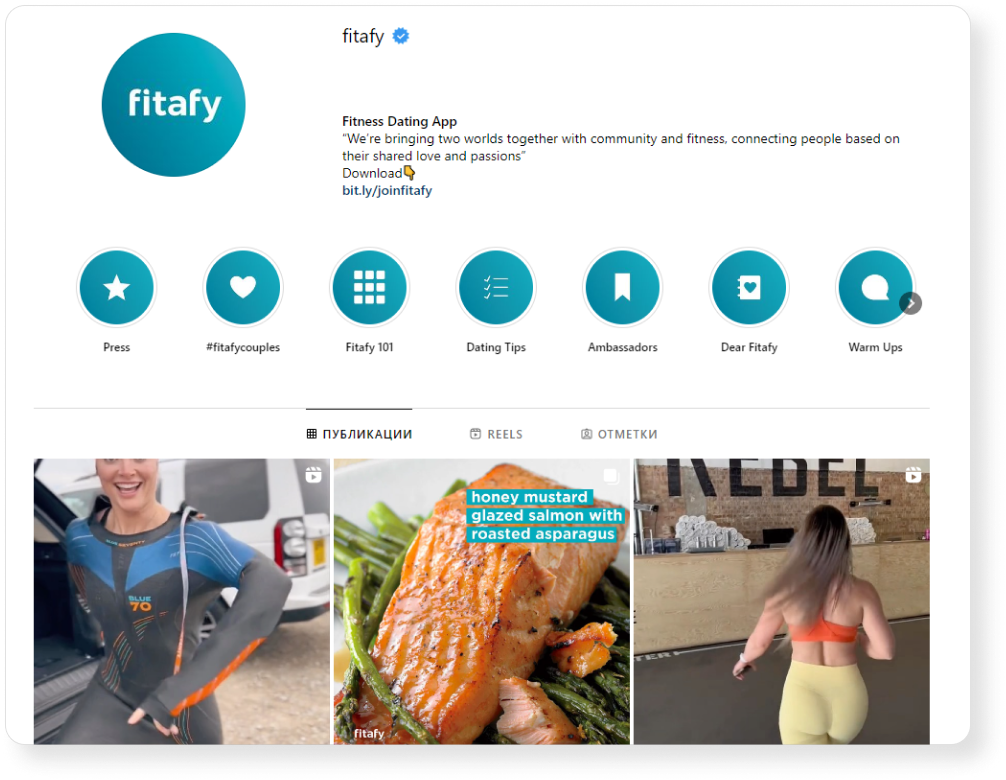
3. App popularity. If an app is already well-known and widely used, then it may not require as much social media marketing as a newer or lesser-known app.
4. Budget. SMM can require a significant investment in time and resources, so an app’s budget can also be a factor in deciding whether to pursue SMM or not.
If you want to make the most of working with social media, we reccomend you create a social media strategy. Here are the key elements that a social media strategy should include:
1. Goals and objectives that the brand wants to achieve through social media marketing. These goals should be specific, measurable, achievable, relevant, and time-bound.
2. Target audience that the brand wants to reach through social media. This includes their demographics, interests, behaviors, and social media usage patterns.
3. Social media platforms the brand will use to reach its target audience.
4. Content strategy which explains how to promote an app on social media. This should be based on the interests and needs of the target audience and aligned with the brand’s overall messaging and values.
5. Metrics and analytics that the brand will track to measure the success of its social media marketing efforts.
By considering these factors and developing a comprehensive social media marketing strategy for apps, app marketers can effectively leverage SMM to reach and engage their target audience.
7. Using influencer marketing
Influencer marketing can help you to increase installs and improve brand awareness. However, for some apps, it may not always be necessary or appropriate. For example, utilities that help solve common tasks. If you have a scanner or recording voice app, you probably don’t need to promote them with influencers.
Ultimately, the decision to use influencer marketing should be based on the specific needs and circumstances of your app, including its target audience, budget, and overall marketing strategy.
If you decided to promote your app with influencer marketing, here are some guidelines you should follow:
1. Identify relevant influencers who have a significant following among your app’s target audience and whose values align with the app’s messaging and values.
2. Set campaign goals you want to achieve through influencer marketing, such as increasing downloads, driving traffic to its website, or creating buzz around a new feature.
3. Develop a partnership with the influencer and clearly define your expectations, compensation, and deliverables for the campaign.
4. Create engaging content that resonates with the target audience and showcases the app’s key features and benefits.
5. Share content on social media including Instagram, YouTube, and TikTok, to reach a wider audience.
6. Track results. Track the results of the campaign, such as the number of downloads or engagement rates, to evaluate its effectiveness and make the necessary adjustments for future campaigns.
By using influencer marketing, app developers can leverage an influencer’s credibility and reach to connect with their app’s target audience, increase brand awareness, and achieve the app’s marketing goals.
8. Publishing articles and press releases about your app
With articles you can showcase app features and functionality, and build credibility by sharing your expertise and knowledge about the industry or problems your app solves. Articles in well-known media can also help you to drive downloads to your app.
Apps that are new, innovative, or solve a unique problem can benefit greatly from articles on blogs. These types of apps may not be well-known to potential users, and articles can help raise awareness and explain how the app works.

Source: techrunch.com
On the other hand, if you have utility apps with obvious features, such as a calendar, notebook, or scanner, then writing an article about it isn’t the best promotional method. Also, apps that are similar to existing apps may not need articles on blogs.
Here are 6 steps your should follow to promote your app with articles:
1. Identify blogs and media that are relevant to your app’s target audience.
2. Develop an angle to your story to attract attention from bloggers and journalists. Try to develop a story angle that is newsworthy and compelling.
3. Write a press release that highlights the angle of your app’s story and includes information such as app features, benefits, and screenshots.
4. Reach out to editors of blogs and media outlets in which you want to publish your article. Send them a personalized email or message that includes your press release and highlights how your app is relevant to their readers.
With a good mobile content marketing strategy, you can increase brand recognition and attract potential users to your app.
9. Creating a referral system
Referral systems can be beneficial for various types of apps, but their effectiveness depends on the app’s goals, target audience, and competition.
Apps that rely on User Acquisition and Retention, such as social networking apps, e-commerce apps, and subscription-based apps, can benefit from a referral system. It can help these apps reach a wider audience, increase engagement, and retain existing users.
If an app has limited functionality or is intended for short-term use, a referral system may not be as effective in attracting new users. For example, countdown apps are intended for short-term use and may not have a significant user base to generate referrals.
When creating a referral system for an app, there are several key factors to take into account:
1. Incentives. Consider incentives that are valuable to your users and fit with your app’s brand and mission.
2. Referral mechanics. Decide how users will refer others to your app. This can be done through a referral code, unique link, or other tracking mechanisms.
3. Promotion. Plan how you will promote your referral system to your users. Consider using in-app messages, social media, email marketing, or other channels to reach your target audience.
4. Tracking and analytics. Use analytics tools to track your referral program’s performance and monitor your ROI.
5. Terms and conditions. Define the terms and conditions of your referral program, including eligibility requirements, incentives, and any limitations or restrictions.
By taking these factors into account when creating a referral system for your app, you can increase your chances of success and generate significant growth and user loyalty.
10. Building a community around your brand
Building a community around your app can be a powerful way to increase engagement, loyalty, and user acquisition.
Apps that rely on user engagement, feedback, and social aspects can benefit from building a community around their brand. This includes social networking, e-commerce, gaming, and education apps.
For example, PUBG has its own page on Reddit, where players share their experiences and game developers post news about the game.

Source: reddit.com
However, apps with a limited target audience or one-time use may not require community building. Examples include productivity and weather apps.
Here are some tips on how to build a community around your app:
1. Define your community. Who are your ideal users, and what are their needs and interests? This will help you determine what kind of community you want to build and what type of content and engagement will be most effective.
2. Choose the right platforms where your target community is most active. This could include social media, forums, blogs, or other online communities.
3. Create valuable content that is relevant to your community. This could include tutorials, tips and tricks, user-generated content, or behind-the-scenes looks at your app’s development.
4. Foster engagement within your community by responding to comments and feedback, hosting contests or giveaways, or featuring user-generated content.
5. Listen to feedback and use it to improve your app and community engagement. This could include adding new features or addressing user concerns.
6. Host events that bring your community together in person or virtually. This could include events in your games, meetups, webinars, etc.
By incorporating these community-building tips into your app marketing strategy, you can build a strong and engaged user community that can increase user acquisition, loyalty, and brand awareness. A strong community can also provide valuable feedback and insights that can help you improve your app and build long-term success.
11. Developing a website for your app
Developing a website for your app is important for increased visibility, brand awareness, improved credibility, better user engagement, analytics, and tracking.
Apps that require a web presence to showcase features, provide information, and engage with users such as e-commerce, social networking, business, productivity, and gaming apps can benefit from having a website. However, apps with a limited scope or niche target audience may not require a website.
When building a website for your app, there are several key factors to consider:
1. Purpose. Define the purpose of your website and what you want to achieve. Is it to showcase features, provide information, offer customer support, or sell products? This will help you determine what content and functionality to include.
2. Design. Choose a design that aligns with your app’s brand and mission. Make sure your website design is visually appealing, user-friendly, and responsive across all devices.
3. Content. Create high-quality, relevant, and engaging content that is tailored to your target audience. This could include tutorials, testimonials, reviews, and other resources.
4. SEO. Optimize your website for search engines by including relevant keywords in your content and meta tags. This will help improve your website’s visibility and drive traffic.
5. User experience. Focus on creating a seamless user experience by providing clear navigation, fast loading times, and easy-to-use features.
6. Analytics. Use analytics tools to track your website’s performance and user behavior. This will help you optimize your website and marketing efforts based on data-driven insights.
6. Integration. Make sure your website is integrated with your app and other marketing channels. This includes links on your app page on the App Store and Google Play, social media, email marketing, or other promotional channels.
By considering these factors when building a website for your app, you can create an effective online presence to boost your app’s visibility, engagement, and user acquisition. A well-designed and optimized website is one of the most important marketing strategies for apps, which can help showcase your app’s features, build brand awareness, and provide a seamless user experience for your target audience.
12. Running email campaigns
Most apps can benefit from an email strategy to engage with users and promote their features. However, apps that can especially benefit from an email strategy include:
1. E-commerce apps: promote sales, new products, and offers, as well as provide order and shipping updates.
2. Social networking apps: promote new features, highlight user-generated content, and encourage engagement.
3. Business and productivity apps: provide users with helpful tips, case studies, and other resources to improve their productivity and streamline their work.
4. Health and fitness apps: encourage users to stay on track with their goals, provide motivation and tips, and offer personalized support.
5. Travel apps: promote travel deals and new destinations, and offer personalized travel recommendations based on user preferences.
While creating an email strategy it is important to follow these guidelines:
Define the goals you want to achieve with your email strategy, whether it’s to increase app usage, promote new features, or improve user engagement.
Build your email list by collecting email addresses through your app, website, and social media channels. Offer incentives such as discounts or exclusive content to encourage users to sign up.
Segment your list based on user behavior, demographics, or other factors. This allows you to create more personalized and relevant email campaigns for each segment.
Plan your content and make sure it aligns with your campaign goals. Include app updates, promotions, user stories, and other relevant information that provides value to your users.
Overall, a well-defined email marketing strategy for apps can help in engaging with users and promote app features, thereby increasing app usage and downloads. By providing personalized and valuable content, apps can build strong relationships with their users and achieve long-term success.
How to promote your app with 12 app marketing strategies
In this article, we covered 12 important mobile app marketing strategies to consider when promoting your mobile app:
1. Conducting App Store Optimization. This can help increase your visibility and attract more users to download your app.
2. Choosing the right Paid UA channels. Investing in Paid User Acquisition can be an effective way to reach a broader audience and drive downloads.
3. Working with app reviews. This is crucial for app success, as it helps improve user experience, increase app ratings and downloads.
4. Getting your app featured. Being in the App Store and Google Play can significantly boost your app’s visibility and downloads.
5. Launching push notifications. By implementing push notifications that are tailored to your app and its users, you can encourage users to return to your app.
6. Working on SMM. Utilizing Social Media Marketing can help expand your reach and engage with your target audience in a more personal way.
7. Using influencer marketing. Implementing influencer marketing strategies can help you reach your target audience, increase your app downloads and boost your revenue.
8. Publishing articles and press releases. This kind of content about your app can be an effective app marketing strategy for building brand awareness, generating interest, and driving downloads.
9. Creating a referral system. Implementing a referral program can incentivize users to share your app with others, leading to increased downloads and user acquisition.
10. Building a community around your app. Fostering a community of users and advocates can help build brand loyalty and drive user engagement.
11. Creating a website for your app. A well-designed website can help drive traffic and conversions.
12. Running email marketing campaigns. Effective email marketing can help you stay in touch with your users and promote new features or updates.
By implementing these app marketing strategies, you can increase downloads and revenue. Receive regular updates on the latest news on App Store Optimization, along with valuable content on ASO, mobile marketing, and managing app reviews by subscribing to our newsletter.


